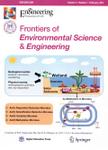Whole pictures of halogenated disinfection byproducts in tap water from China's cities
Whole pictures of halogenated disinfection byproducts in tap water from China's cities作者机构:State Key Laboratory of Pollution Control and Resource Reuse School of the Environment Nanjing University Nanjing 210023 China Environmental Engineering Program Department of Civil and Environmental Engineering The Hong Kong University of Science and Technology Clear Water Bay Kowloon Hong Kong China
出 版 物:《Frontiers of Environmental Science & Engineering》 (环境科学与工程前沿(英文))
年 卷 期:2015年第9卷第1期
页 面:121-130页
核心收录:
学科分类:0830[工学-环境科学与工程(可授工学、理学、农学学位)] 08[工学] 0815[工学-水利工程]
基 金:supported by a grant from the Research Grants Council of the Hong Kong Special Administrative Region China
主 题:Disinfection byproducts (DBPs) total organichalogen tap water in China
摘 要:When bromide/iodide is present in source water, hypobromous acid/hypoiodous acid will be formed with addition of chlorine, chloramine, or other disinfectants. Hypobromous acid/hypoiodous acid undergoes reactions with natural organic matter in source water to form numerous brominated/iodinated disinfection byproducts (DBPs). In this study, tap water samples were collected from eight cities in China. With the aid of electrospray ionization-triple quadrupole mass spectrometry by setting precursor ion scans of m/z 35, m/z 81, and m/z 126.9, whole pictures of polar chlorinated, brominated, and iodinated DBPs in the tap water samples were revealed for the first time. Numerous polar halogenated DBPs were detected, including haloacetic acids, newly identified halogenated phenols, and many new/unknown halogenated compounds. Total organic chlorine, total organic bromine, and total organic iodine were also measured to indicate the total levels of all chlorinated, brominated, and iodinated DBPs in the tap water samples. The total organic chlorine concentrations ranged from 26.8 to 194.0 μg· L 1 as Cl, with an average of 109.2 μg·L-1 as Cl; the total organic bromine concentrations ranged from below detection limit to 113.3 μg·L-1 as Br, with an average of 34.7 μg·L-1 as Br; the total organic iodine concentrations ranged from below detection limit to 16.4 μg· L-1 as I, with an average of 9.1 μg· L-1 as I; the total organic halogen concentrations ranged from 31.3 to 220.4 μg·L-1 as Cl, with an average of 127.2 μg· L- 1 as Cl.



